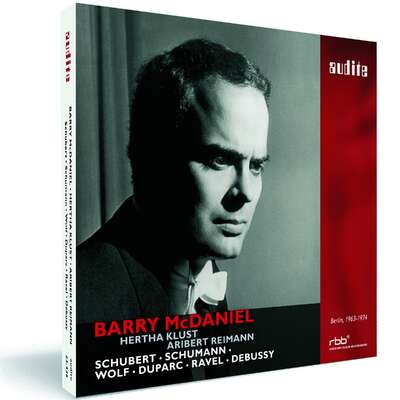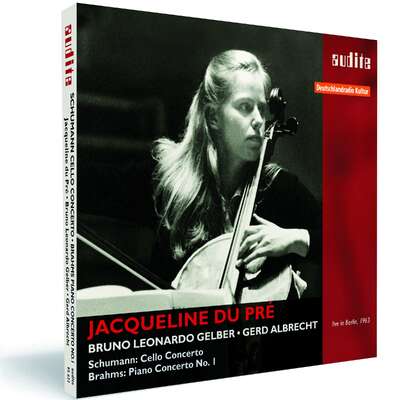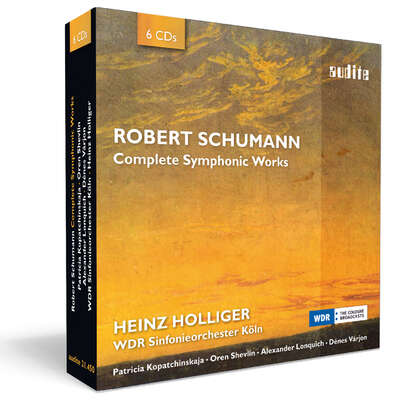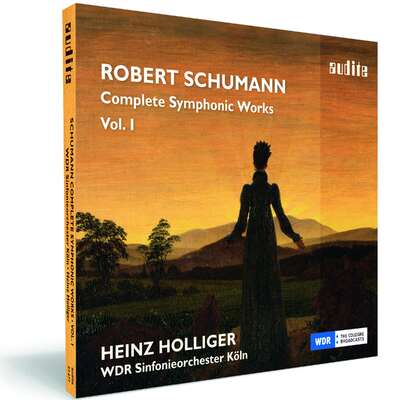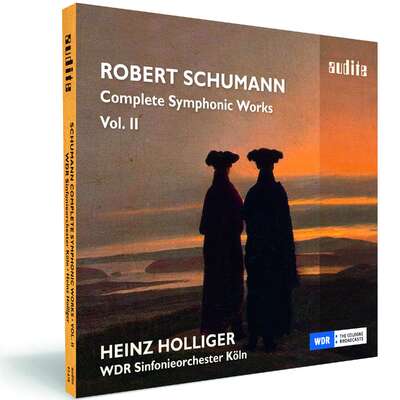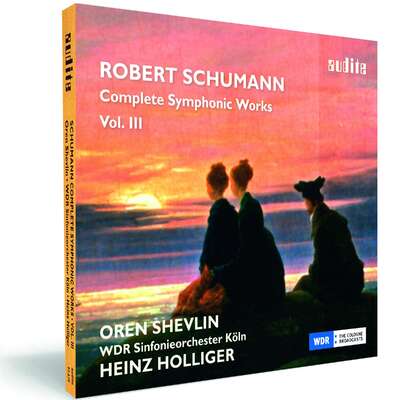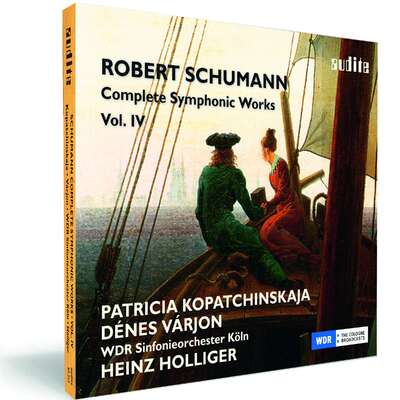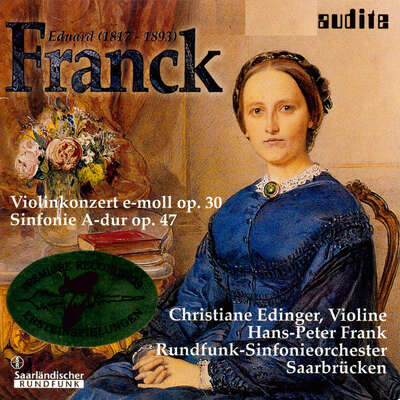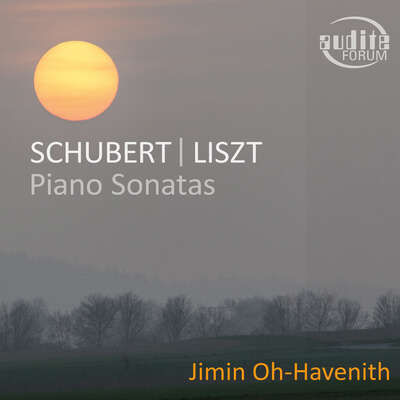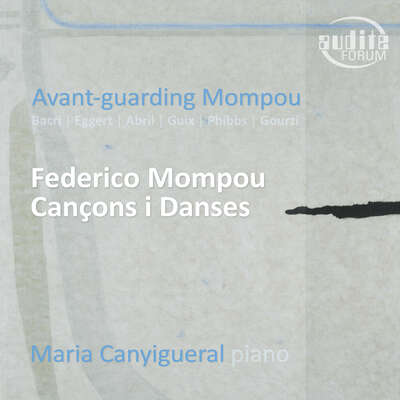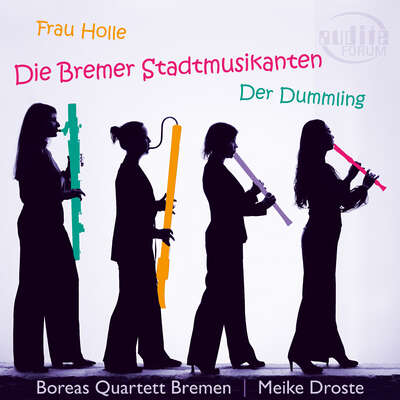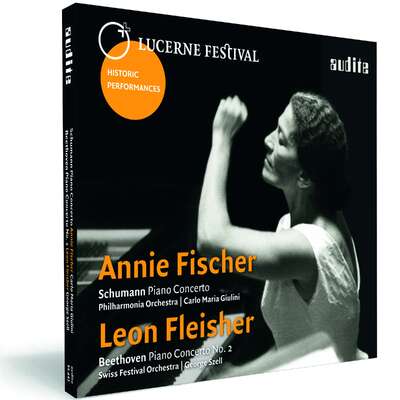
Zum Abschluss der Edition schlägt die CD den Bogen von Schumanns erstem sinfonischem Schaffen bis hin zu den Spätwerken der Ouvertüren, die in ihrer Kompaktheit seine sinfonische Meisterschaft dokumentieren.mehr
"Jeder Takt macht neugierig auf den nächsten, jede Kantilene wirkt frisch und sportlich, ohne zu hasten." (niusic.de)
Details
| Robert Schumann: Complete Symphonic Works, Vol. VI | |
| Artikelnummer: | 97.705 |
|---|---|
| EAN-Code: | 4022143977052 |
| Preisgruppe: | BCA |
| Veröffentlichungsdatum: | 8. April 2016 |
| Spielzeit: | 75 min. |
Zusatzmaterial
Informationen
Zum Abschluss der Edition schlägt die sechste CD den Bogen von Schumanns erstem sinfonischem Schaffen bis hin zu den Spätwerken der Ouvertüren, die in ihrer Kompaktheit seine sinfonische Meisterschaft dokumentieren.
Die Ouvertüren, die alle nach 1847 entstanden, bilden eine notwendige Ergänzung zu den Sinfonien. Sie verhalten sich zu jenen wie die Konzertstücke zu den mehrsätzigen Solokonzerten. Schumann konzipierte sie teils als Vorspiele für Opern, Oratorien oder Bühnenmusiken, teils als selbständige Stücke; teils wollte er mit ihnen „ein Bild des Ganzen" geben, teils „nur einleiten" und auf das Drama hinführen. Neben den großen und kleinen Vokalwerken, neben der poetischen Erneuerung der Sinfonie bezeugen sie die große Bedeutung der Literatur für Schumanns musikalisches Denken und Gestalten.
Ergänzt werden die Ouvertüren von der Sinfonie Nr. 1, der sogenannten Zwickauer Sinfonie. Sie ist der erste Versuch des Komponisten in der sinfonischen Gattung, der öffentliche Aufführungen erlebte, obwohl das Werk unvollständig blieb.
Besprechungen
Correspondenz Robert Schumann Gesellschaft | Nr. 39 / Januar 2017 | Irmgard Knechtges-Obrecht | 1. Januar 2017
Die Musiker des WDR Sinfonieorchesters finden aufgrund des feinnervigen und auf Schumann spezialisierten Dirigats von Heinz Holliger für jedes Werk den entsprechenden Ton, was diese CD besonders farbenreich und vielseitig werden lässt. Mehr lesen
Das Orchester | 11/2016 | Jörg Loskill | 1. November 2016 | Quelle: http://www.dasor...
Der vielseitige Musiker Heinz Holliger ist als Dirigent ein kenntnisreicher Schumann-Exeget, der zusammen mit dem Maßstäbe setzenden WDR-Orchester alles zum Leuchten, Glühen und Brillieren bringt, was der Komponist anstrebte: einfach schöne Musik aus dem Geist der pulsierenden und aktuellen Romantik, ungebrochen, aber nachhaltig reflektiert.Mehr lesen
Fanfare | October 2016 | Peter Burwasser | 1. Oktober 2016
This is the sixth and final volume of Audite’s survey of the complete symphonic works of Robert Schumann. As is often the case with suchMehr lesen
While there are no revelations in this program, the music is generally of high quality, even though it comes from the end of Schumann’s career, perhaps something of a rejoinder to the “truism” that Schumann’s abilities and imagination had eroded somewhat at this point. The problem for the listener, at least this one, is that the blustery nature of this dramatic music becomes a bit wearisome by the end of a complete listening. In hindsight, it may have made more sense to have included these dramatic overtures in more varied programs of symphonies and concertos, as is usually the practice in presenting such work. The exception is the early attempt at symphonic writing by a 21-year-old Schumann, the incomplete Symphony in G-Minor, named for the city it was premiered in, Zwickau. It is replete with lovely writing, with the composer’s signature firmly in place.
The complete set of Schumann orchestral music by these forces is certainly a success by almost any measure. I would offer one caveat, and that is that the WDR SO, while excellent and a great pleasure to hear, lacks the ultimate degree of polish and finesse of the top-tier orchestras of the world. But I’m not sure how much that matters in this material, given that a certain degree of lustiness, if anything, enhances the expressiveness of the music.
American Record Guide | September / October 2016 | Stephen Wright | 1. September 2016 | Quelle: http://www.ameri...
This is Volume 6 of Audite’s Complete Symphonic Works edition and contains Schumann’s earliest and latest pieces for orchestra, including all hisMehr lesen
Beethoven’s influence is also obvious in the only non-overture here, the unfinished Zwickau Symphony of 1833; this is Schumann’s third and final revision of the first movement, so it lacks the slow intro of John Gardiner’s 1998 recording (DG 457591). Gardiner’s orchestra has 40 strings where Holliger’s has 60, plus Holliger’s accents are tempered and his pace relaxed, so I heard for the first time the influence of Louis Spohr—another hero of the young Schumann—in the wilting chromaticism of the s tring figures.
Before the two-movement symphony, Holliger raises the curtain on the concert with the mature sonata-form Manfred Overture. In it we hear Holliger’s approach to all the overtures: warm, genial, and flowing. He lets the dramatic tension build up slowly, free of histrionics, with subtle orchestral flexibility to broaden tempos for grand climaxes and lyrical passages. The violins are split left and right as they were in Schumann’s time and they play cleanly, without vibrato, and this clarifies Schumann’s allegedly thick and clumsy orchestrations. There’s no mention anywhere of period instruments or gut strings, so I assume they’re modern, but at 60 strong they don’t sound shrill, nor do they indulge any supposed historic practice like swelling on long notes.
The sound quality matches interpretation: warm, full, and detailed, especially the surround-sound recording, right now available only as a download from Audite’s website (mentioned on the back of the digipak). The improvement in three-dimensional depth and presence is unmistakable in the five overtures recorded in 2010 but subtle in the symphony and Manfred recorded in 2015. Considering the high quality of both performance and surround-sound recording, I hope Audite issues a boxed set of this complete series on SACD (or Blu-Ray).
The booklet is informative, recounting the circumstances of each piece’s composition. This is an attractive and rewarding survey of Schumann’s overtures and makes me want to hear the other volumes in the series.
Fono Forum | August 2016 | Michael Kube | 1. August 2016 Empfehlung des Monats
Ein großer Zyklus kommt zum Abschluss. Nach den Sinfonien, Konzerten und Konzertstücken stehen in der letzten Folge der nahezu rundwegMehr lesen
Holliger aber sind anscheinend gerade diese Partituren ans Herz gewachsen – so ausgeglichen und wirklich als große Werke gespielt habe ich sie noch nicht gehört. Und sie zeigen Schumann im vollen Besitz seiner Fertigkeiten. Wer noch immer von angeblichen Problemen bei der Instrumentation spricht, sollte eher von Problemen der jeweiligen Interpretation sprechen (einer meiner persönlichen Favoriten ist und bleibt die Ouvertüre zu "Julius Cäsar"). Der für Schumann charakteristische, kompakte Klang kommt jedenfalls dem Sinfonieorchester des WDR entgegen, das schon fünf der Kompositionen 2010 eingespielt und sich den "Manfred" wie auch die frühe, unvollständig gebliebene Zwickauer Sinfonie in g-Moll nun für das Finale aufgespart hat – nicht als Supplement, sondern als geniale Vorschau auf das, was noch kommen sollte. So gespielt wirken die beiden Sätze denn auch nicht als philologische Kuriositäten, sondern künstlerisch berechtigt. Aus Holligers Nähe zu Schumann ist hier mit kühlem Kopf etwas Erstrangiges erwachsen.
Gramophone | August 2016 | David Threasher | 1. August 2016
With this sixth and final volume in his series of the 'Complete Symphonic Works', Heinz Holliger mops up the remaining segment of Schumann'sMehr lesen
That makes Holliger's the most complete cycle of the orchestral works to have arrived in ages. Dausgaard's three single discs (BIS) took in all the symphonic works (including both versions of the Fourth Symphony) along with the six overtures, while Gardiner's triple-set, on period instruments, dispensed with the overtures but included the wonderful Konzertstück for four horns and orchestra. If and when Holliger's six full-price discs come out in a budget-price box, that'll make this easily one of the most attractive collections of this music.
For those less bothered about such notions of completeness, other attractions include Holliger's clear-sighted interpretations, revealed in sound that is focused without being over-analytical. Perhaps the youthful 'Zwickau' piece and the much later concert overtures can't boast the winning melodies that make the greatest of Schumann's works stand out but they display all the composer's motivic skills and his development of the Beethovenian model in his own Romantic language, and offer valuable alternative lights on his orchestral career.
www.peterhagmann.com
| 13. Juli 2016 | Peter Hagmann | 13. Juli 2016 | Quelle: http://www.peter...
Ein Fall für die ideale Diskothek
Die Orchestermusik Robert Schumanns in Aufnahmen mit dem Dirigenten Heinz Holliger
Wer wissen möchte, wie Schumann im besten Fall klingen kann, wird um diese sechs Compact Discs nicht herumkommen.Mehr lesen
www.limelightmagazine.com.au
| July 2016 | Philip Clark | 1. Juli 2016
Thinking-Man's Schumann
Holliger's scholarly perspective impresses in symphonic mop-up
No man or woman alive knows more about the inner-workings of Schumann's music than Holliger, [...] teases out those melodic and harmonic fingerprints about to blossom in his mature symphonies. His Manfred Overture reminds us of the daring instability of Schumann's harmony – a music that opens the door, and takes a peek, at some harmonic traits of 20th-century music. The final volume has a slight feeling of mopping up what was left; but Holliger's interpretive perspectives make it worthwhile.Mehr lesen
hifi & records | 3/2016 | Ludwig Flich | 1. Juli 2016
Nun ist Holligers Schumann-Projekt abgeschlossen, und die Qualität hat sich von CD zu CD noch gesteigert. [...] Wer nach mehr Selbstverständlichkeit im Klang sucht, dem rate ich, alternativ die Flac-Version (48/24; auch in Surround) von der Audite-Website herunterzuladen.Mehr lesen
RBB Kulturradio | Do 09.06.2016 | Dirk Hühner | 9. Juni 2016
Robert Schumann ist für den Schweizer Oboisten, Komponisten und Dirigenten Heinz Holliger mehr als eine Passion. Seit seiner Jugend ist er geradezuMehr lesen
Die sechste und letzte Folge sämtlicher sinfonischer Werke von Schumann umfasst sechs Ouvertüren und die frühe so genannte "Zwickauer Sinfonie". Wie bei den vorangegangenen Teilen entfaltet sich auch hier eine fein abgestimmte Dramaturgie, die verschiedene Lebensphasen und Stoffe zu einem größeren Bild zusammenfügt. Schon in der vom 21-jährigen Schumann in mehreren Anläufen zu Papier gebrachten "Zwickauer Sinfonie" weht und zirkuliert ein unruhiger Geist. Die in den 1850er Jahren, und also als "spät" apostrophierten Ouvertüren lenken diesen Geist auf literarische Stoffe von Shakespeare, Goethe, Schiller und Lord Byron. Aufruhr herrscht auch hier, aber doch in dramatische Form gegossen.
Schnelle Umschwünge
Dass die Ouvertüren heute kaum noch im Konzertleben anzutreffen sind, ist ein Manko des weniger auf klassische Bildung als auf Effekt zielenden Konzertbetriebs. Zumindest hat Heinz Holliger mit diesen Aufnahmen alle Vorurteile gegenüber einer groben Orchestrierung oder Gedankenschwäche bei Schumann gründlich widerlegt. Die Marseillaise in der Ouvertüre zu Goethes "Herrmann und Dorothea" ist nicht der einzige revolutionäre Ton, der hier immer wieder anklingt. Das Obsessive von Schumanns notorischen Motivdrehungen und –windungen schlägt hier Funken. Dabei sind die Tempi nirgends übertrieben schnell. Holliger strafft vor allem die Dynamik, die schnelle Umschwünge vollführen kann, ohne Nebenstimmen zuzudecken. Das WDR Sinfonieorchester Köln hat sich hier einen überraschend hellen Schumann-Ton erarbeitet, der fast kammermusikalisch erscheint.
Wenn diese CD mit den Fanfarentönen der "Julius Caesar"-Ouvertüre zu Ende geht, ist damit auch ein Aufnahmezyklus vollendet, der noch lange Bestand haben wird als einsichtige und Einsichten verschaffende Schumann-Gesamtschau.
Crescendo Magazine | Le 22 mai 2016 | Ayrton Desimpelaere | 22. Mai 2016 Fin d’une très belle intégrale Schumann par Heinz Holliger
Ce dernier volume est clairement l’aboutissement d’une réflexion et Heinz Holliger ne vient pas ici pour faire de la redite. A la tête d’un très bel orchestre, il dépoussière le répertoire avec bienveillance et respect du texte en prêtant une attention particulière à ce que rien ne soit figé. Entre le regard porté sur les enchainements harmoniques et le souffle de la ligne musicale, Holliger joue de son orchestre et développe le discours musical grâce à des tempi allants assumés et maîtrisés. Une masse généreuse au service du texte et d’un répertoire bien trop souvent massif et négligé. Il y a ici un travail considérable sur la texture, le flux, le timbre et l’homogénéité des pupitres qui ne peut être effectué que par un chef de talent.Mehr lesen
www.niusic.de
| 13.05.2016 | Konrad Bott | 13. Mai 2016 | Quelle: http://www.niusi...
Liebevolle Ausnüchterung
Wenig Schmelz, viel Energie – Heinz Holligers Schumann erfrischt und hält auf Trab
Wo Akzente gesetzt werden, wird auch die hartnäckigste Schnarchnase aus dem Bett geschubst. Jeder Takt macht neugierig auf den nächsten, jede Kantilene wirkt frisch und sportlich, ohne zu hasten. Dass Schumanns sinfonischen Werke nicht nur etwas für romantische Schwelger sind, hat Holliger mit dieser Aufnahme ein für allemal klargestellt.Mehr lesen
Thüringen Kulturspiegel | Mai 2016 | Dr. Eberhard Kneipel | 1. Mai 2016
AIte Schönheit - neuer Glanz
Die Gesamtaufnahme von Robert Schumanns Orchesterwerken beim Edel-Label audite
Erster Anlauf, erstaunliche Experimente, imponierende Meisterwerke: Ein außergewöhnliches und an Entdeckungen reiches Hör-Erlebnis ist zu haben – auch dank audite!Mehr lesen
The Guardian | 2016/Apr/28 | Andrew Clements | 28. April 2016 Holliger makes Manfred crackle
Anyone who has followed Holliger’s series won’t be disappointed by this final instalment.Mehr lesen
Kölner Stadtanzeiger | Freitag, 22. April 2016 | Markus Schwering | 22. April 2016
Kampf gegen den Taktstrich
WDR Sinfonieorchester Holliger beendet glänzend seine Totale des orchestralen Schumann
Schließlich gelingt es Holliger, wirkungsvoll ein altes Vorurteil zu dementieren: dasjenige vom unfähigen Orchestrator Schumann und seinem fett-opaken Instrumentalsatz. Der Dirigent orientiert sich bei seinen WDR-Aufnahmen an der historischen Aufführungspraxis: Er dramatisiert, belüftet, entschlackt den Klang, verschärft Akzente, reduziert das Streicher-Vibrato, lässt die Bläserstimmen plastisch heraustreten, verwendet überhaupt auf die Balance der Gruppen größte Sorgfalt. Das Ergebnis: Der reife Schumann klingt hier, auch ohne angezurrte Tempi, jugendlich frisch.Mehr lesen
Stuttgarter Zeitung | 22.03.2016 | Dr. Uwe Schweikert | 22. März 2016
Eine Großtat für Robert Schumann
Heinz Holliger und das WDR Sinfonieorchester Köln nehmen das gesamte sinfonische Werk auf
Man sagt wohl nicht zu viel, wenn man diese CDs als die wichtigste Schumann-Einspielung seit langem rühmt. Sie beweist, dass es keines historischen Instrumentariums und auch keines Spezialistenensembles bedarf, um die Werke aus dem Geist der Zeit für heute aufs Neue zu verlebendigen.Mehr lesen
Record Geijutsu | 2016.5
Japanische Rezension siehe PDF!Mehr lesen


























